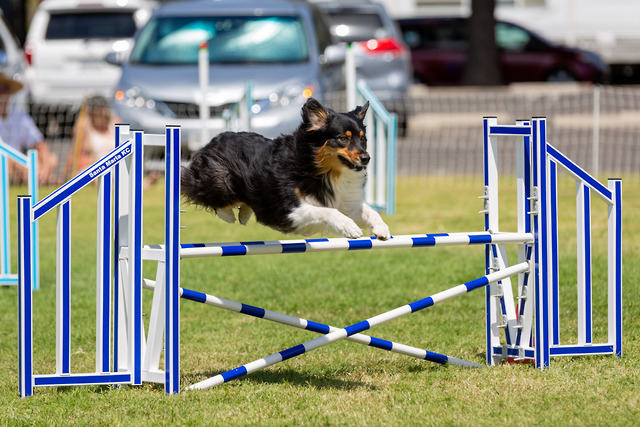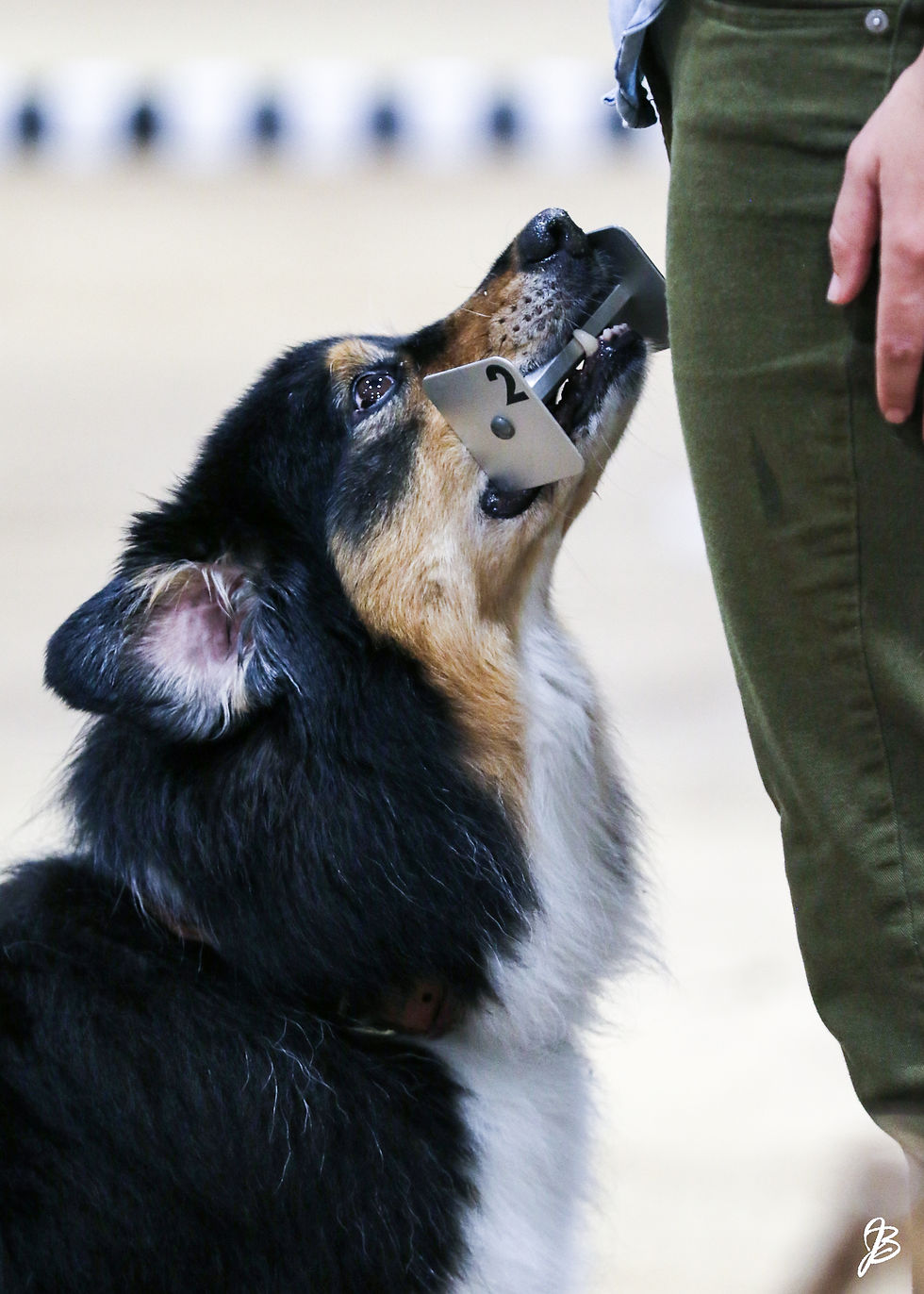Learning from dog shows, skills for everyday dog parents
- Caiti Price
- Nov 7, 2023
- 7 min read

Some of us as kids dreamed of big dog shows with our family fido. Soaring over jumps, catching high flying discs, having perfect obedience and winning blue ribbons. Yet as we start our adult lives and get our own family pets, (that we are responsible for instead of our parents) the goals can shift to just having a good family dog. Maybe just one that doesn't pull on walks, get into the trash or jump on our guests.
Yet for anyone that chooses to watch any dog shows that are broadcasted on TV, there is something more valuable than the fastest dog on an agility course or the dog that is the best in show. There are a few things that I have learned trialing and showing my dog that make me a better dog owner and trainer for everyday life skills outside of the ring.
Yesterday I returned with my dog from attending the 2023 Australian Shepherd Club of America's National Specialty. We got to compete in three different sports and there were almost 1000 dogs competing in eight different sports. (Agility, conformation, herding, obedience, rally obedience, dock diving, scentwork and tracking). While the skills required are vastly different for each sport, there are things they all have in common. These things in common are things that all dogs (not just competition dogs!) should get.
No matter the sport the dog is competing in there are a few things that every sport dog has to have to be able to do to achieve any success, regardless of what sport they are doing, before they even hit the show grounds.
Socialization
Handler Focus
Handling Pressure
Understanding the Needed Skills
Lets talk about these!
Socialization
Show dogs are expected to be able to be in crowded and pretty hectic environments. Not only are there tons of dogs and people EVERYWHERE, you often have tons of other things going on. There are loud noises, different surfaces, weird smells, tight spaces and so on. A small list of things I saw dogs having to deal with at the ASCA National:
Long Car Rides
Crate time
Blow Dryers
Golf Carts
Bikes
Scooters
Kids
Livestock (cattle, sheep and ducks)
Dogs Barking
Dogs Running
Being within 5' of another dog and not interacting
Passing by lots of dogs in small spaces
Clapping (lots of clapping)
A fence falling over in a competition ring
Being handled by strangers
So much more

Now how do show people just get dogs that are good at handling all of these situations? From the times these dogs are puppies most 'show' people just start bringing the puppies with them. I saw plenty of 4 month old puppies walking around the show grounds, being exposed to all the sights, noises and experiences of being at a big show. I saw people with puppies under 4 month old being carried around (gotta stay safe until they get all their vaccines!) so they got to see and hear all the things going on.
Show people start practicing grooming, handling and exposure very early and these dogs grow up in these environments. These puppies get used to all of this right from the start.
Another point with socializing is that show dog's typically get socialized with neutrality. It is an unwritten rule that you do not let your dog go up to another dog or person that you don't know at a show. So dogs and puppies get very used to ignoring other dogs and people. Being close to but not interacting with people or other animals on a normal basis is one of the most important parts of socialization! That is the biggest reason while I think dogs that are raised by sport and show people do not get as many reactivity, hyper social, and/or fear issues! This is the type of socializing I aim for with my own animals and with my client's puppies.
Handler Focus
When it comes to any type of dog, this is crucial! Being able to navigate through a show area alone can be hard with a dog that doesn't even know you're at the other end of the leash! Let alone being able to be successful in any sports. Even for conformation (think classic show dogs being judged on appearance) if they did not follow their handler, or focus on their handler (or even the food the handler has), they would never place because the judge could not accurately asses their structure.

Then when you look at any type of performance event (herding, agility, obedience, and so on) there is always a component of the handler and the dog working together. The dog can't just run around doing whatever it wants because then you might not be able to complete the tasks needed. You need to be able to direct and cue the dog and they need to focus on you to do that.
With our dogs at home, teaching handler awareness and a little bit of focus can make our lives so much easier. If your dog is aware that you are at the end of the leash on walks, it makes teaching loose leash walking so much easier. Handler awareness is crucial for off leash work. Then if you need to give any cues to your dog, its a lot easier when they look to you for direction instead of having to bed for their attention.
While our dog's at home will never need a head up, staring at our face, formal heel, its nice to have a dog that notices you stopped and doesn't keep walking and pulling until you physically stop them with the leash. This is also taught with training and rewarding often for offered focus and attention.
Handling Pressure
One of the hardest parts of showing a dog is teaching them to handle the pressure of competing. While dogs may never feel the anxiety of wanting to win ribbons or place well, they deal with a lot of pressure that we may not think about. There are so many little details that may become 'weird' to the dog in a show environment compared to everyday life.

Some examples of these things are walking through a narrow entrance way or gate into a ring. (Confined or narrow spaces can be hard for a lot of dogs.) A judge formally following you around and staring at your dog. Stewards coming to take your leash from you. Spectators staring from outside the ring. A nervous and stressed owner/handler. All of these things (and more, trust me) put pressure on the dog. As a good trainer for competition sports its important to train my dog to know that these are normal and okay. That the first time my dog deals with being followed, examined or stared at doesn't happen their first time in the show ring. So I practice setting up scenarios to create positive experiences with all these little details that we people may not think about but our dogs definitely notice.
Just like for shows its important to get our dog's used to the world and the pressure they may experience. Is that walking through a crowd? Or a narrow aisle of a pet-friendly store? Is it making sure they are used to strangers handling them so they feel confident with the vet or groomer? Is it preparing them for other people staring so when the young kid sees your cute dog and they stare very intently at you dog, your dog doesn't get worried about it. Preparing our dog for 'weird' situations helps them understand that they don't need to be worried about 'weird' things. Sometimes weird just happens. Remember that sometimes weird can mean crazy movements or noises, or it can mean stillness and staring. Helping our dogs get used to these things helps them in everyday life no matter what happens to them.
Understanding Needed Skills
This one is pretty obvious for most people. You can't expect to win a chess game if you don't know how to play. Or maybe you've played checkers, the board looks the same and some of the pieces move the same, but there are different rules on how to play. This goes the same for our dogs in and outside of a competition.
The hard part about this comes to understanding that dogs don't generalize as well as we do. Just because our dog can sit well at home, doesn't mean they can sit well inside Lowes. It can take time to help a dog understand that sit means sit at home, in the park, in the car, when kids run past, when you're at a distance, when they laid down first...and a whole other list. We often have to consider that dogs pick up on context of where they are and what is going on. So if the where, how and what changes, they may not understand us.

When preparing a dog for any competition, its important that you make sure they know how to do the needed behaviors in many different areas and with many different levels of distraction. Once again this is a skill to work on before you even enter the ring. I like to make sure my dog knows how to heel at home, in a park, in Lowes, in a pet store and through a crowd before I even try to get into a competition for heeling.
For our pet dogs, its important to work on the skills we want in many different locations as possible. Can your dog loose leash walk in your house? Your backyard? Your front yard? The local park? Those are all things I want to make sure my dog understands and can do before I try loose leash walking in a pet-friendly store or a busy event. If they can't loose leash walk in my backyard, they for sure are not going to be able to do it at a farmer's market.
So your dog should have all the needed skills before you put them in the situation where they need it. For a patio dog, they should know how to settle when you're sitting down and ignore other people and dogs. You don't train that at a patio, you train those skills first before you go to the patio.
In conclusion
So while you may never have any interest in competing in any dog sports, when training you can learn so much from the skills that sport people need to have success in the ring. While I don't explain them as sport skills, I often bring back skills I've learn while competing to help family dogs be the best they can be at home. Understanding the extremes of training for perfection makes me a better trainer for my clients to help them reach their goals.
Its often a great idea to join classes that train for dog sports like rally obedience, agility, scentwork and so on. Cause not only does it give you a mental and physical outlet for your dog, it also helps train so many skills for everyday life that you will find useful. Its the unspoken stuff that helps our dogs be the wonderful companions that they can be.
I will continue to learn and grown both as a trainer for the everyday family dog and for the competition dogs. Taking the best skills for both worlds and combining them for the best outcome for my clients and my own dogs.






Comments